2023 Dodge Hornet: Performance-Oriented Small SUV Lands Under $30,000


Competes with: Alfa Romeo Tonale, Hyundai Kona N, Lexus UX, Mazda CX-30, Toyota RAV4 Prime
Looks like: The Alfa Romeo Tonale with Dodge-specific styling tweaks
Powertrains: 265-horsepower, turbocharged 2.0-liter four-cylinder engine with nine-speed automatic transmission (Hornet GT); “285-plus” hp (system), turbo 1.3-liter four-cylinder hybrid with six-speed automatic (R/T); standard all-wheel drive
Hits dealerships: Late 2022 (GT), spring 2023 (R/T)
The roster of small SUVs is rapidly expanding, but while most are designed to accommodate urban living or tight budgets, few are geared toward spirited driving — and even fewer combine performance leanings with an electrified powertrain. Enter the all-new 2023 Dodge Hornet, offering shoppers the choice of a gas-only turbocharged engine or a plug-in hybrid model and the promise of sportier driving dynamics from both.
Related: Up Close With the 2023 Alfa Romeo Tonale
The Hornet will be the first compact SUV and PHEV in Dodge’s current lineup, slotting below the mid-size Durango SUV. It takes after the 2023 Alfa Romeo Tonale revealed in February, sharing its underpinnings — as well as much of its exterior design and technology. (Alfa Romeo and Dodge are both sibling brands under parent automaker Stellantis.)
A Family Resemblance
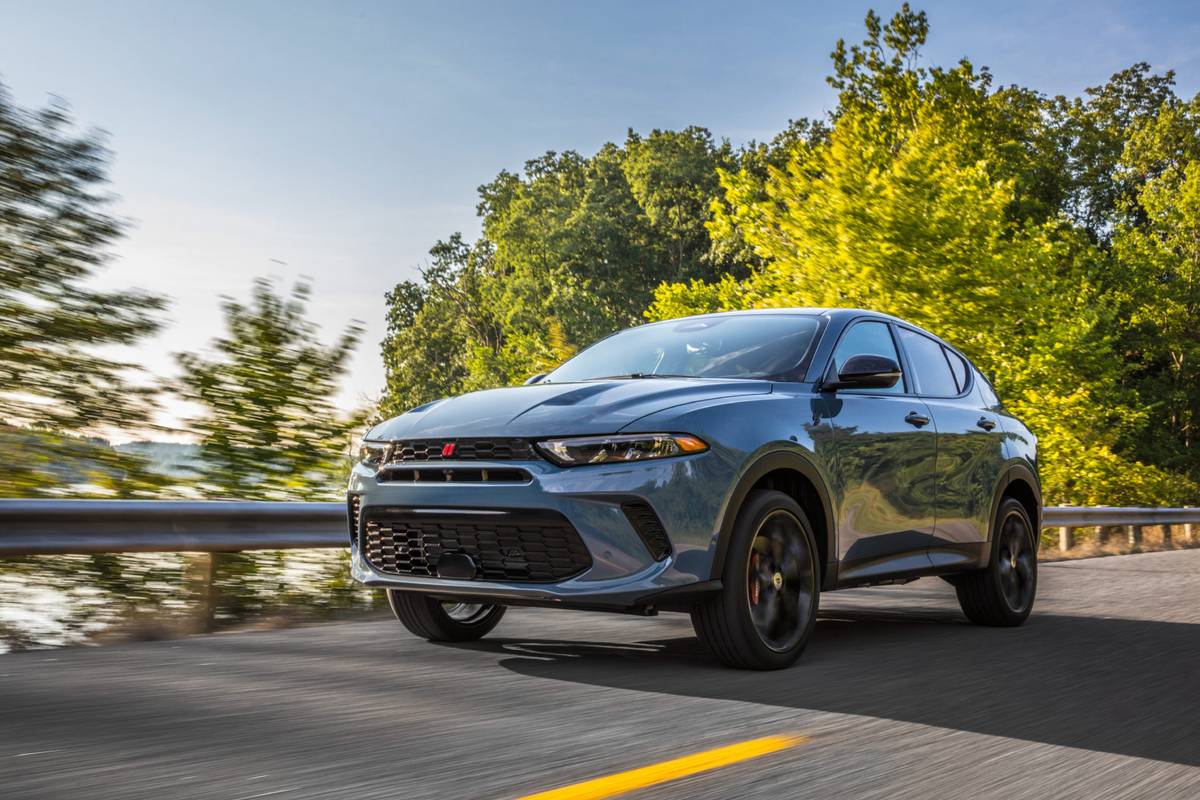
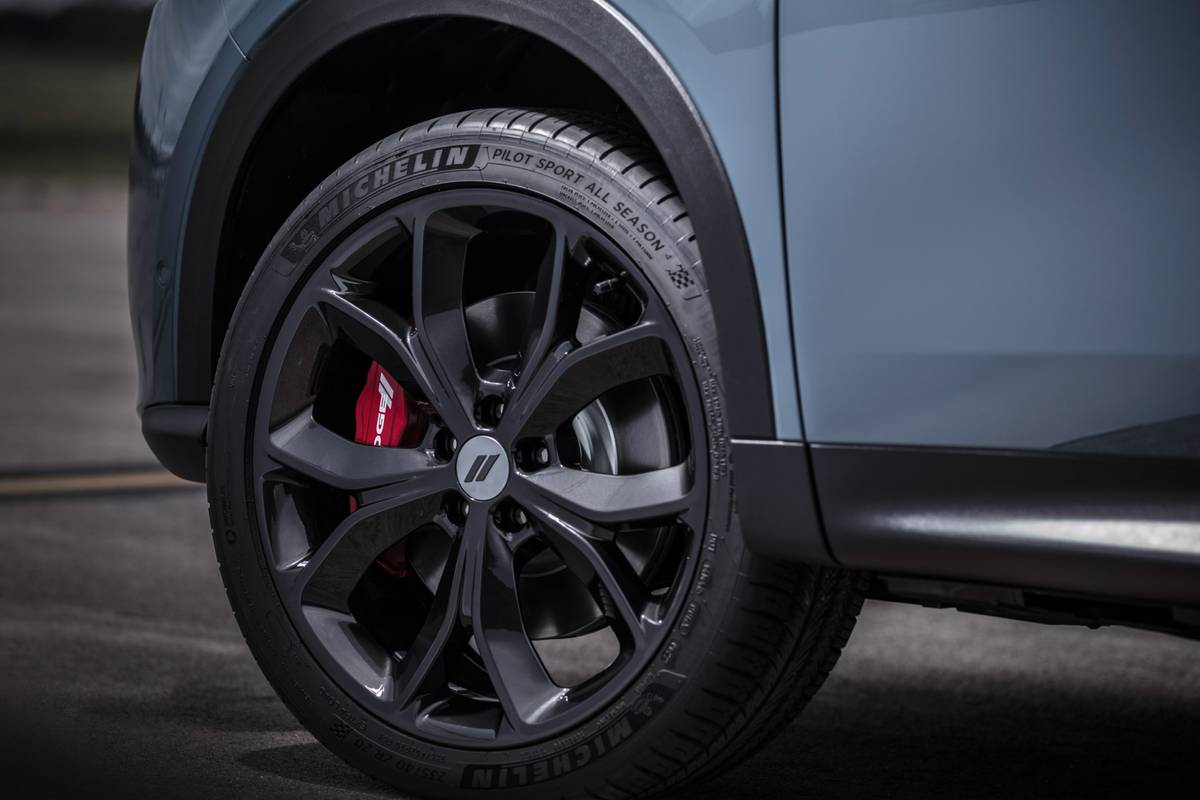
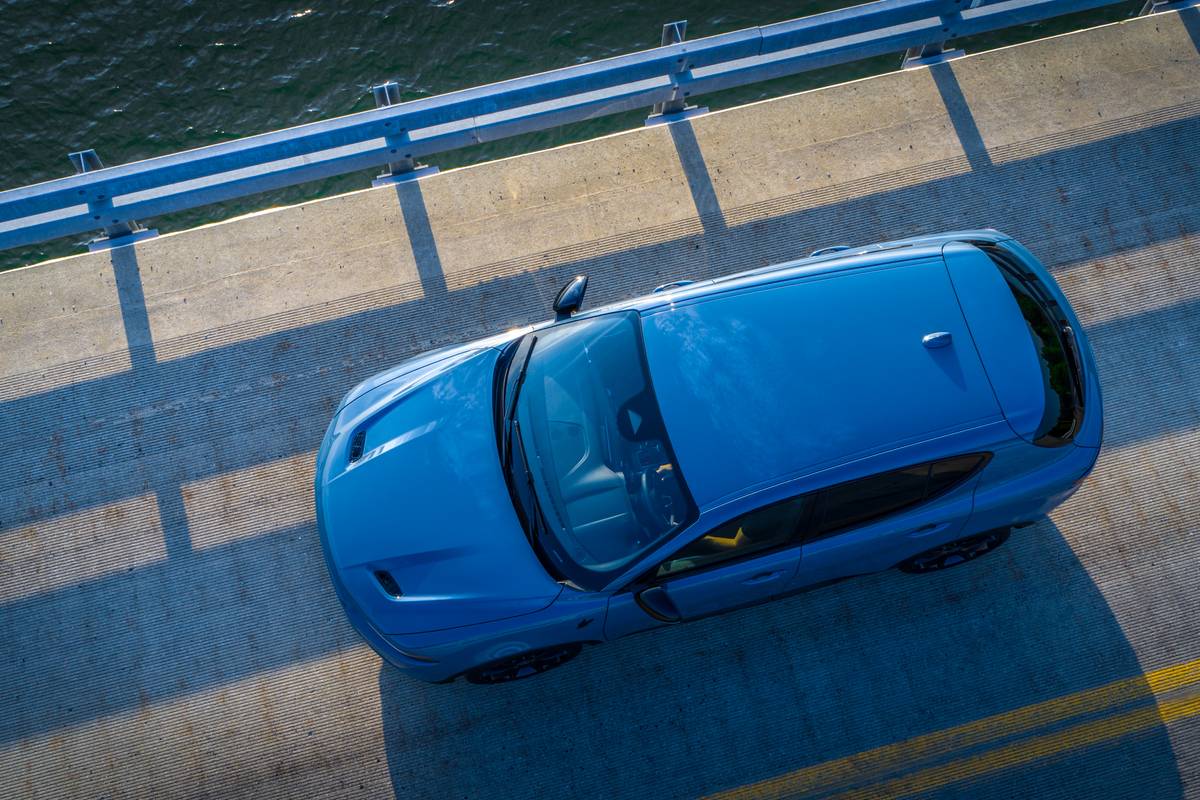











The 2023 Hornet gets a distinct front end, headlights and hood, but apart from those features, the SUV bears a strong resemblance to the Tonale. It has a similar shape and shared sheet metal, including on the doors and roof. Exterior elements like integrated heat extractors in the hood and a mail-slot grille hint at the small SUV’s performance muscle. The GT model wears matte-black lower cladding and 17-inch alloy wheels, while the R/T has painted cladding, integrated dual exhaust ports and 18-inch Graphite Grey alloy wheels. Both variants get standard LED headlights as well as a red signature taillight bar and illuminated Dodge logo in back. A Hornet badge completes the look and carries on Dodge’s tradition of logos.
The Hornet’s interior is meant to be driver-focused and provide visual cues to the SUV’s performance, Dodge says. The center stack controls and display screens are tilted to face the driver, and controls like Sport mode and Hybrid mode (the latter specific to the R/T) are integrated into the vehicle’s flat-bottom steering wheel.
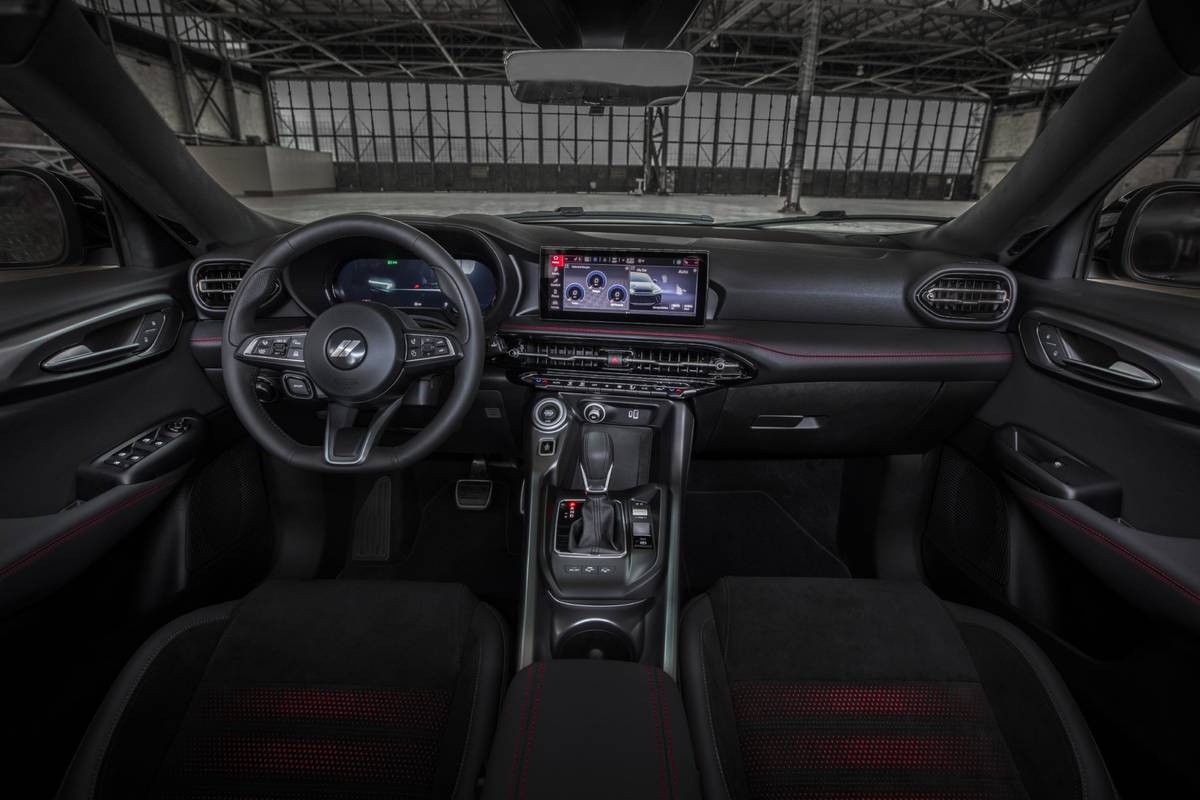
Standard materials for the GT and R/T include a combination of cloth and leatherette upholstery, with optional leather or racing-inspired Alcantara seats; red accent stitching is standard on all models. Range-topping GT Plus and R/T Plus variants get standard leather upholstery; red leather is optional. Additionally, two packages will be available: The Blacktop adds 18-inch black-alloy wheels and gloss-black exterior accents, while the Track Pack gets 20-inch wheels, red Brembo brake calipers and package-specific logos on the seats.
Electrified Power Optional
Like the Tonale, the Hornet offers two powertrains: The base engine for the GT is a turbocharged 2.0-liter four-cylinder that makes an estimated 265 horsepower and 295 pounds-feet of torque; it’s mated to a nine-speed automatic transmission. According to Dodge’s estimates, the GT gets a top speed of 140 mph and a 0-60 mph time of 6.5 seconds when the vehicle’s available Sport mode is activated.
The R/T plug-in hybrid swaps the base engine and transmission for a turbo 1.3-liter engine paired with a 90-kilowatt electric motor, 15.5-kilowatt-hour lithium-ion battery pack and six-speed automatic; it’s good for an estimated 285 hp and 383 pounds-feet of torque. The R/T offers more than 30 miles of all-electric range and can be fully charged in about 2.5 hours with Level 2 charging, based on Dodge’s estimates. All-wheel drive is standard on both models, but the R/T’s AWD system offers improved capability by automatically distributing power between the SUV’s engine and motor for instant torque and optimized traction. The R/T’s estimated 0-60 time is 6.1 seconds with a top speed of 128 mph.
In addition to Sport mode (also standard on the GT), the R/T has a PowerShot feature that adds 25 hp for 15 seconds and shaves a second off the 0-60 time when activated, according to Dodge. When the primary goal is fuel efficiency, however, R/T drivers can select from three hybrid modes: Hybrid, Electric and E-Save. Similar to other Stellantis PHEVs, Hybrid uses both gas and electric power at once, while Electric uses only electric power and E-Save preserves battery charge by only using the internal-combustion engine.
Standard performance features for both R/T and GT models include frequency-selective damping shocks to optimize control and ride comfort, dynamic torque vectoring, and an independent front and rear suspension for improved cornering. The R/T tacks on standard Brembo front brake calipers and a brake-by-wire braking system with regenerative braking. It also gets chassis modifications to optimize weight distribution and handling.
Tech and Safety

Not only does the Hornet resemble the Tonale from the outside, but its technology and safety features will also look familiar. A 12.3-inch customizable digital gauge cluster and 10.25-inch central touchscreen come standard along with Stellantis’ Uconnect 5 system, which features wireless Android Auto and Apple CarPlay and Amazon Alexa. Wireless phone charging and a premium Harman Kardon 14-speaker audio system are available options.
The Hornet’s standard safety suite includes adaptive cruise control, forward collision warning with automatic emergency braking and pedestrian and cyclist detection, blind spot warning with rear cross-traffic alert, and lane departure warning. Available advanced driver-assist features include Level 2 semi-autonomous capability with adaptive cruise control, traffic sign recognition, traffic jam assist and lane-centering steering down to a stop. An advanced parking assist system and 360-degree camera system are optional.
More From Cars.com:
- 2023 Alfa Romeo Tonale: Alfa Gets Electrified With New Baby SUV
- Here Are the 10 Cheapest New SUVs You Can Buy Right Now
- What Are the Most Fuel-Efficient Cars for 2022?
- Dodge Durango: Which Should You Buy, 2021 or 2022?
- 2021 Dodge Durango SRT or SRT Hellcat: Is the Hellcat Worth It?
Trims, Release Date and Pricing
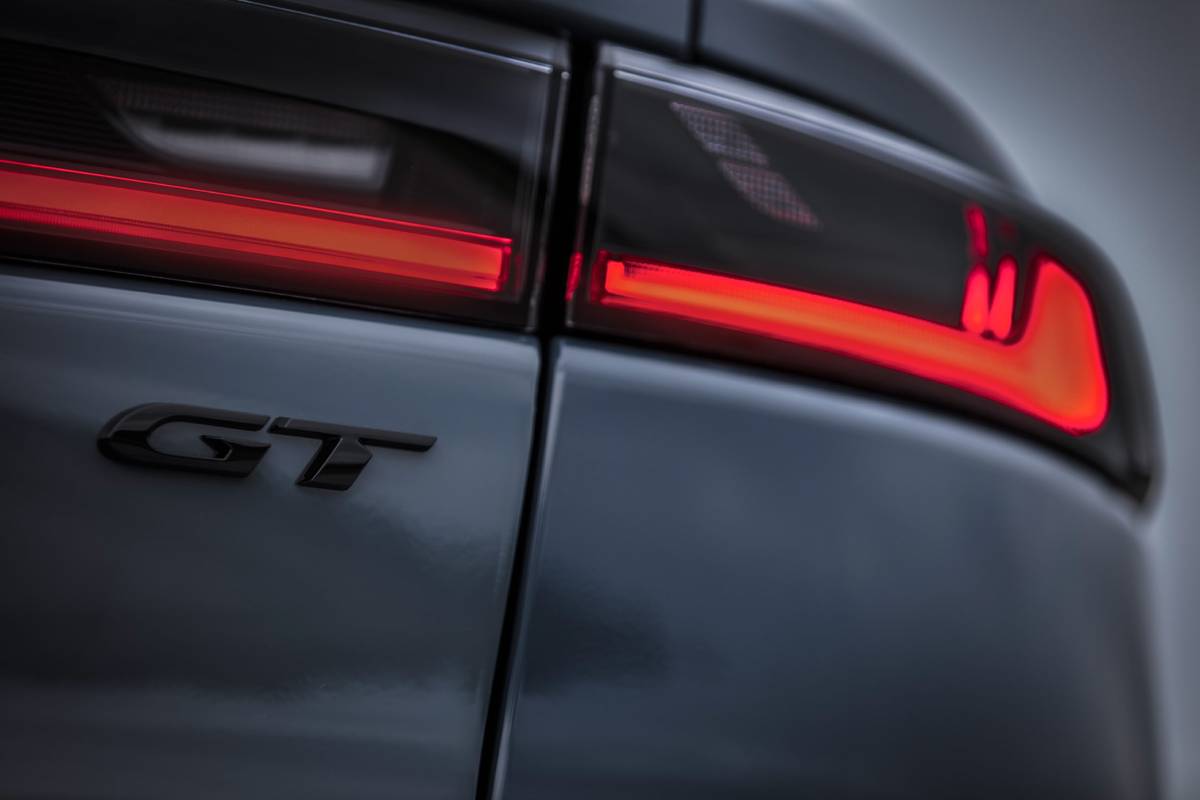
Shoppers can place an order for the 2023 Dodge Hornet starting on Wednesday; the base GT is expected to arrive in December, and the R/T will follow in spring 2023; range-topping Plus trims will be offered for both variants.
Although the brand has not yet revealed pricing, it says the base GT will have a starting price of less than $30,000. How the Hornet’s performance will stack up against rivals like the Hyundai Kona N, Lexus UX, Mazda CX-30 remains to be seen. The 276-hp Kona N and 250-hp CX-30 2.5 Turbo offer comparable performance specs, while the similarly sized UX plug-in may rival the R/T for efficiency — though it comes with notably less power (181 hp).
The base GT should undercut most of its competitors in price, at least: The 2022 Kona N starts at $35,495, the 2022 CX-30 2.5T at $31,775, and the UX 250h at $34,775 (prices include destination). Pricing for the Alfa Romeo Tonale will be available in late 2022.
Related Video:
Cars.com’s Editorial department is your source for automotive news and reviews. In line with Cars.com’s long-standing ethics policy, editors and reviewers don’t accept gifts or free trips from automakers. The Editorial department is independent of Cars.com’s advertising, sales and sponsored content departments.

Former News Editor Jane Ulitskaya joined the Cars.com team in 2021, and her areas of focus included researching and reporting on vehicle pricing, inventory and auto finance trends.
Featured stories










